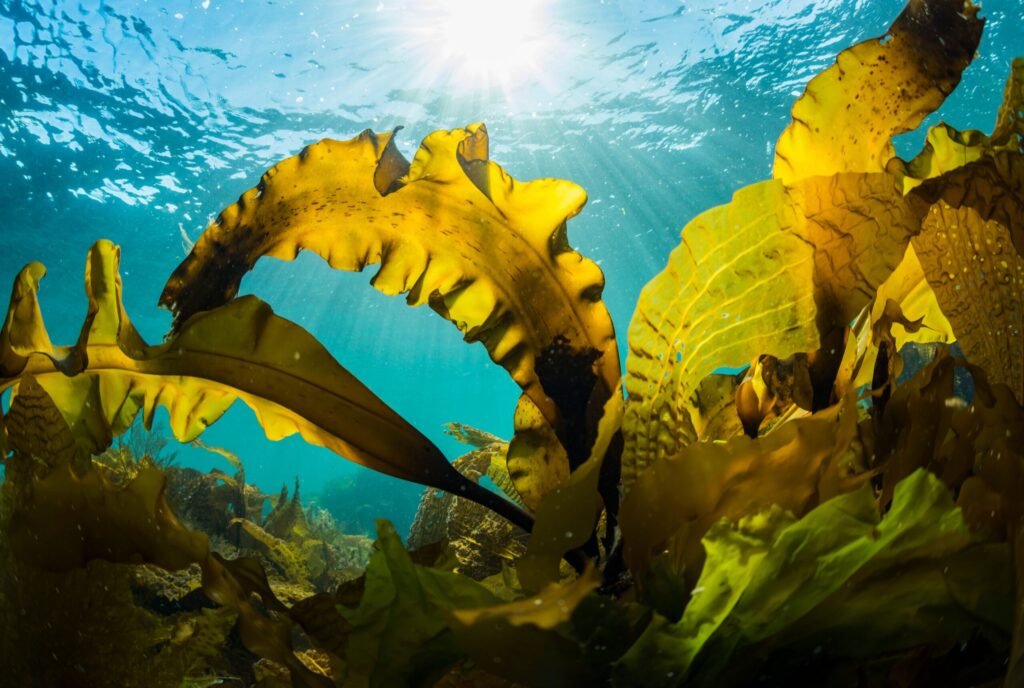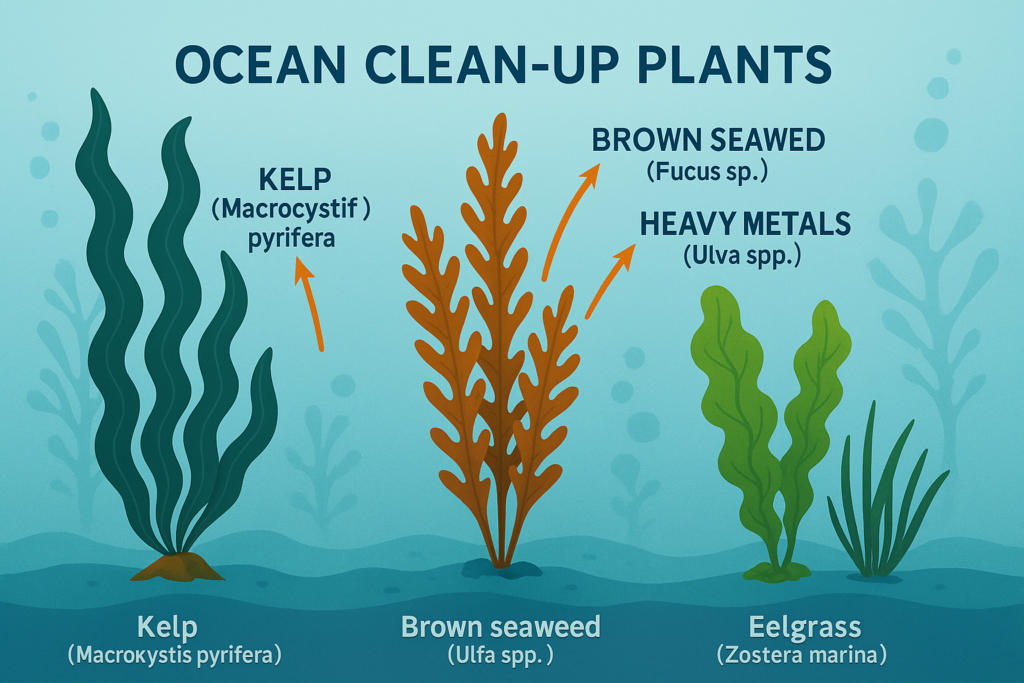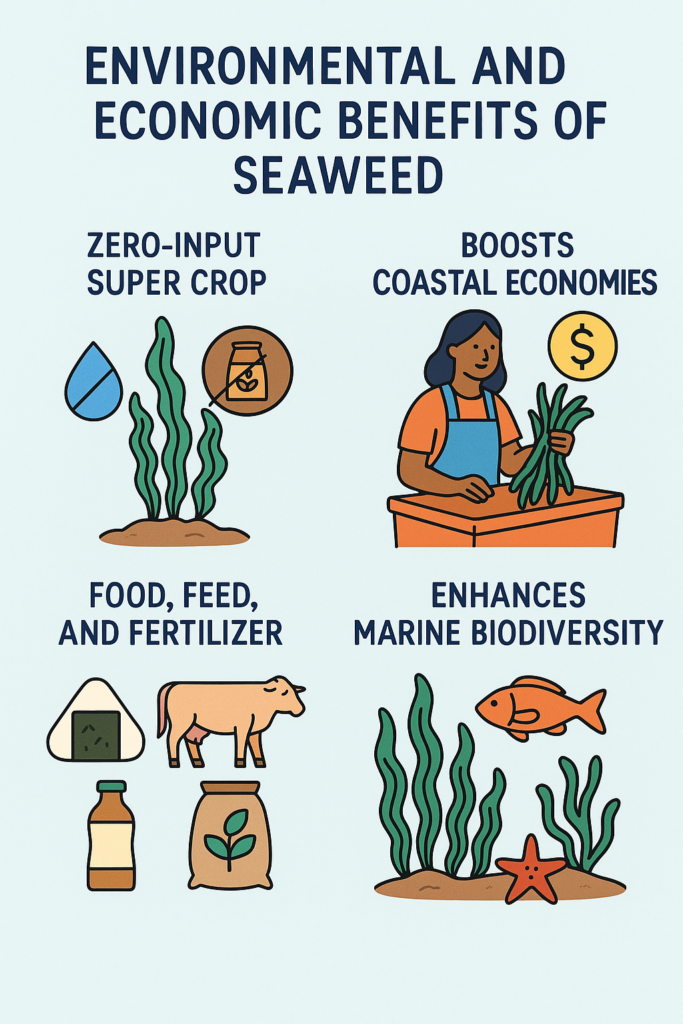How Seaweed Cleans Polluted Oceans
Introduction:
Seaweed, often dismissed as ocean debris or sushi wrap, holds an extraordinary secret: it can clean polluted water in ways few natural systems can. From industrial pollutants and agricultural runoff to atmospheric carbon dioxide, seaweed addresses multiple environmental crises simultaneously. This marine plant, which grows in oceans, seas, and even some freshwater bodies, is now the focus of groundbreaking studies in environmental science, aquaculture, and sustainable development.
The real secret lies in its biology. Seaweed has evolved to absorb nutrients and minerals directly from water, giving it a unique ability to act like a biofilter. With pollution threatening marine life and coastal communities, seaweed might just be the green miracle we need.

1. How Seaweed Absorbs Pollutants
Nutrient Absorption: The Fertilizer Filter
When farmers use fertilizers rich in nitrogen and phosphorus, these chemicals often leach into streams, rivers, and eventually the ocean. Once in the water, they cause a process called eutrophication, where excessive nutrients stimulate algal blooms. These blooms deplete oxygen levels, killing fish and creating so-called “dead zones.”
Seaweed, however, thrives on these very nutrients. As it grows, it absorbs nitrogen and phosphorus from the surrounding water, incorporating them into its own tissues. In essence, seaweed acts as a natural fertilizer sponge, pulling harmful nutrients out of the water and converting them into useful biomass.
Species like Ulva (sea lettuce) and Saccharina (kelp) are especially good at this and are often used in aquaculture systems to remediate nutrient-rich waters.
Heavy Metal Absorption: Detoxifying the Ocean
Heavy metals such as mercury, cadmium, arsenic, and lead often enter marine environments through industrial discharge, mining, and urban runoff. These metals are toxic to marine organisms and can enter the food chain, eventually harming humans.
Seaweed species have a cell wall structure rich in polysaccharides like alginate, fucoidan, and carrageenan. These molecules have negatively charged sites that bind with positively charged metal ions. This binding immobilizes the heavy metals, allowing them to be removed from the water.
Once the seaweed is harvested, it can be treated to recover the metals, or safely disposed of to prevent recontamination.

2. How Seaweed Cleans Carbon from the Water
Photosynthesis in Overdrive: Turning CO₂ into Oxygen
Like terrestrial plants, seaweed absorbs carbon dioxide (CO₂) through photosynthesis. But here’s the kicker—seaweed grows much faster than most land plants, with some species like giant kelp growing up to 2 feet (60 cm) per day under ideal conditions.
This means it can sequester large amounts of carbon in a very short time. For every ton of dry seaweed biomass, several tons of CO₂ are removed from the environment.
Tackling Ocean Acidification
Excess CO₂ dissolves in seawater, forming carbonic acid. This lowers the pH of the ocean and is especially harmful to calcifying organisms like corals, mussels, and plankton, which need calcium carbonate to build shells and skeletons.
Seaweed helps by pulling CO₂ out of the water and increasing local pH levels. This not only protects marine biodiversity but also enhances the resilience of coral reefs and shellfish farms nearby.
3. Seaweed Farms: Nature-Based Water Treatment Plants
Integrated Multi-Trophic Aquaculture (IMTA)
In traditional fish farms, uneaten feed and fish waste degrade water quality. IMTA solves this problem by combining different species from various trophic levels in one system. Here’s how it works:
- Fish or shrimp provide waste (rich in nutrients).
- Seaweed absorbs these nutrients.
- Shellfish filter the water and feed on smaller particles.
This creates a closed-loop system where nothing is wasted, and water quality is naturally maintained. Seaweed plays a central role in this system as the primary nutrient recycler.
Case Study: China’s Massive Seaweed Network
China produces over 60% of the world’s seaweed, and its farms are not just for food or cosmetics. Large-scale seaweed operations along China’s coast have improved water quality, reduced algal blooms, and even helped reduce marine hypoxia (oxygen depletion).
Researchers have observed that waters near seaweed farms are cleaner, more oxygen-rich, and teeming with marine life, proving that seaweed farming can serve dual purposes economic and environmental.
4. Real-World Applications and Experiments
Kelp Forests in California
In California, scientists have planted kelp forests near wastewater outfalls and areas prone to acidification. The results show reduced nitrogen and phosphorus levels and improved water clarity.
Kelp forests are also being used in experimental marine reserves to boost biodiversity and improve habitat complexity.
European Algae Parks
Countries like Norway, Denmark, and France are developing “algae parks” floating platforms where multiple seaweed species grow in nutrient-rich zones. These parks act as bio-purifiers, while also producing biomass for biofuels and bioplastics.
African Coastal Solutions
In Tanzania and Kenya, seaweed farming by coastal women’s cooperatives is improving water quality in lagoons while providing sustainable livelihoods. These small-scale operations show that seaweed-based water purification can work even in developing regions.
5. Environmental and Economic Benefits
Despite the hurdles, seaweed farming especially for water purification offers an extraordinary blend of ecological and economic rewards.
1. A Zero-Input Super Crop
Unlike conventional agriculture, seaweed does not require:
- Freshwater
- Pesticides
- Fertilizers
- Arable land
This makes it the ideal crop for a water- and resource-scarce future. It thrives on waste, turning pollution into productivity.
2. Boosting Coastal Economies
Seaweed farming creates jobs in:
- Cultivation
- Harvesting
- Processing
- R&D (for bio-plastics, food, and pharmaceuticals)
In countries like Indonesia, Tanzania, and Philippines, seaweed is empowering women’s cooperatives, offering financial independence and food security.
3. Food, Feed, and Fertilizer
Clean, unpolluted seaweed has multiple uses:
- Human food: High in protein, vitamins, and antioxidants.
- Animal feed: Natural, sustainable alternative to soy.
- Fertilizer: Improves soil health without chemical runoff.
Seaweed farming for purification can have secondary revenue streams further enhancing economic viability.
4. Enhancing Marine Biodiversity
Seaweed beds are nurseries and shelters for fish, shellfish, and other marine organisms. By improving water quality and habitat complexity, seaweed fosters:
- Resilient fisheries
- Healthier coral reefs
- Greater species diversity
Unlike artificial filtration systems, seaweed doesn’t just remove pollutants it actively restores and rejuvenates the marine environment.
5. Natural Disaster Mitigation
Dense seaweed forests reduce the impact of:
- Storm surges
- Coastal erosion
- Tsunamis
They buffer shorelines, stabilizing sediments and acting as green infrastructure against natural disasters.

6. Challenges and Considerations
Scaling Without Sacrificing Sustainability
While seaweed has incredible potential, it’s not without its challenges. If scaled carelessly, seaweed farming could lead to ecosystem disruptions, monocultures, or even new kinds of marine pollution.
1. Bioaccumulation and Waste Disposal
When seaweed absorbs toxic heavy metals, it becomes unfit for food, feed, or cosmetics. Managing this “biohazardous seaweed” poses several problems:
- Safe disposal is complex and expensive.
- There’s a risk of toxins re-entering the ecosystem if the seaweed breaks down or is dumped improperly.
- Research is underway into turning contaminated seaweed into biochar or using it in non-consumable products like insulation and construction materials.
2. Marine Space Conflicts
The ocean is already crowded with shipping lanes, fisheries, oil exploration, wind farms, and tourism. Large-scale seaweed farming may conflict with:
- Marine traffic
- Coral reef conservation zones
- Fishing rights of local communities
To succeed, seaweed initiatives must involve community engagement, zoning laws, and multi-use ocean planning.
3. Disease and Pest Management
As seaweed farming grows, so does the risk of:
- Pathogen outbreaks (e.g., marine fungi, bacteria)
- Epiphytes and grazing by sea urchins or snails
- Algal overgrowth in monocultures, leading to oxygen depletion
Unlike land crops, treating seaweed diseases with chemicals is not an option, as it risks contaminating marine life. Natural resilience, crop diversity, and breeding resistant strains are crucial strategies.
4. Policy and Regulation Gaps
In many countries, the legal status of seaweed farming is still vague or underdeveloped. Key issues include:
- Permit procedures
- Harvesting limits
- Quality control for water-purifying applications
Governments need to create comprehensive frameworks that support seaweed cultivation while protecting marine ecosystems and Indigenous rights.
7. The Future of Seaweed in Water Purification
A Blue Revolution is Coming
The future of seaweed in water purification is not just promising it’s pivotal. As the climate crisis accelerates and water bodies face unprecedented levels of contamination, seaweed offers scalable, nature-based solutions. The coming decades may see a shift from traditional, chemical-based water treatment systems to hybrid ecological infrastructures where living organisms like seaweed are key components.
Ocean Farming 2.0: Smart and Self-Sustaining
Imagine floating seaweed farms that not only purify water but also generate energy, monitor pollution, and adapt to changing ocean conditions in real time. That’s the vision behind smart ocean farms, where artificial intelligence (AI), robotics, and biotechnology meet marine biology.
Emerging Innovations:
- Autonomous kelp farms: Using solar-powered drones and AI-controlled underwater buoys, future seaweed farms could operate with minimal human input.
- Real-time water quality monitoring: Sensors embedded in seaweed farms could monitor pH, salinity, temperature, and nutrient levels, sending alerts if pollutants spike.
- Genetically optimized seaweed strains: Scientists are working on enhancing seaweed’s pollutant-absorbing capacity using CRISPR and synthetic biology, making them “super sponges” for heavy metals, CO₂, and nitrogen.
Blue Carbon Credits and Eco-Economies
Seaweed’s role in carbon sequestration is opening doors to its inclusion in blue carbon markets. These are environmental finance systems where companies can offset carbon emissions by investing in seaweed farms that trap CO₂.
Potential benefits:
- Corporations could invest in kelp farms instead of planting trees.
- Coastal communities could receive financial incentives to manage seaweed ecosystems.
- Countries might include seaweed farming in their national climate adaptation plans.
Fusion with Urban Systems
In the near future, we may also see seaweed-based water filtration systems in cities:
- Algae walls in buildings that purify runoff water.
- Seaweed tanks on rooftops to clean rainwater.
- Floating bio-barriers made of seaweed around industrial zones and ports.
Seaweed isn’t just the ocean’s janitor it could be tomorrow’s eco-engineer, integrated into both marine and urban environments.
Conclusion:
Seaweed is no longer just the backdrop of the ocean floor it’s the hero we didn’t know we needed. As our waters face increasing pressure from pollution, rising temperatures, and acidification, seaweed offers a multi-pronged, natural solution.
Its ability to absorb harmful nutrients, sequester carbon, bind toxic metals, and support marine life makes it a living toolkit for ocean regeneration. Investing in seaweed is investing in the future one where oceans are cleaner, communities are stronger, and the planet breathes a little easier.